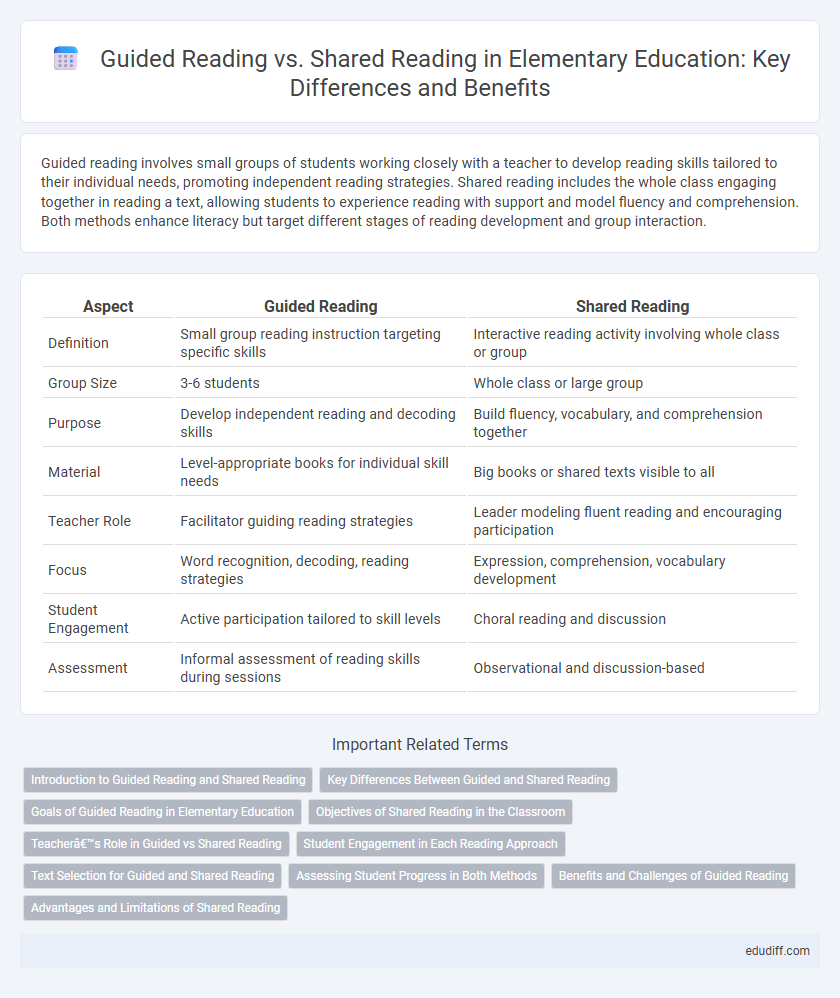Guided reading involves small groups of students working closely with a teacher to develop reading skills tailored to their individual needs, promoting independent reading strategies. Shared reading includes the whole class engaging together in reading a text, allowing students to experience reading with support and model fluency and comprehension. Both methods enhance literacy but target different stages of reading development and group interaction.
Table of Comparison
| Aspect | Guided Reading | Shared Reading |
|---|---|---|
| Definition | Small group reading instruction targeting specific skills | Interactive reading activity involving whole class or group |
| Group Size | 3-6 students | Whole class or large group |
| Purpose | Develop independent reading and decoding skills | Build fluency, vocabulary, and comprehension together |
| Material | Level-appropriate books for individual skill needs | Big books or shared texts visible to all |
| Teacher Role | Facilitator guiding reading strategies | Leader modeling fluent reading and encouraging participation |
| Focus | Word recognition, decoding, reading strategies | Expression, comprehension, vocabulary development |
| Student Engagement | Active participation tailored to skill levels | Choral reading and discussion |
| Assessment | Informal assessment of reading skills during sessions | Observational and discussion-based |
Introduction to Guided Reading and Shared Reading
Guided Reading involves small groups where teachers support students in reading texts matched to their skill levels, fostering individualized comprehension and fluency. Shared Reading is a whole-class activity where the teacher reads a text aloud, encouraging students to join in and engage with the text collectively. Both approaches build foundational literacy skills but differ in group size and reading independence.
Key Differences Between Guided and Shared Reading
Guided reading involves small groups of students reading at similar levels with teacher support to develop reading strategies and comprehension skills, while shared reading features the whole class reading a text together to model fluent reading and foster group discussion. Guided reading sessions emphasize tailored instruction based on individual student needs, whereas shared reading focuses on building a collective understanding of text structure and vocabulary. The key difference lies in the group size, instructional purpose, and the degree of student independence during the reading activity.
Goals of Guided Reading in Elementary Education
Guided Reading in elementary education aims to enhance individual student reading skills by providing targeted support based on each child's reading level and needs. It focuses on developing fluency, comprehension, and decoding strategies through small group instruction and differentiated texts. The goal is to foster independent reading habits and build confidence in young learners.
Objectives of Shared Reading in the Classroom
Shared reading in the classroom aims to build students' reading confidence and fluency through interactive group experiences. It focuses on developing comprehension skills by modeling fluent reading and encouraging student participation with predictable texts. The objective is to create a supportive environment where learners can practice reading strategies and expand their vocabulary.
Teacher’s Role in Guided vs Shared Reading
In guided reading, the teacher acts as a facilitator by working with small groups to target specific reading skills and provide individualized support based on students' reading levels. In shared reading, the teacher leads the entire class in reading a text together, modeling fluent reading and encouraging participation to build comprehension and word recognition. Both approaches require the teacher to actively engage students but differ in group size and instructional focus.
Student Engagement in Each Reading Approach
Guided reading fosters student engagement through targeted, small-group instruction that allows for personalized feedback and active participation. Shared reading promotes engagement by involving the entire class in interactive reading experiences, encouraging collaboration and discussion. Both approaches enhance literacy skills but differ in the level of individual focus and group interaction.
Text Selection for Guided and Shared Reading
Text selection for guided reading involves choosing leveled books that match students' reading abilities to support targeted skill development and fluency. Shared reading uses larger, more accessible texts that allow all students to participate and engage with the content simultaneously, fostering comprehension and a love of reading. Selecting appropriate texts ensures guided reading addresses individual needs while shared reading promotes group interaction and literacy skills.
Assessing Student Progress in Both Methods
Guided reading allows teachers to closely monitor individual student comprehension through targeted questioning and running records, providing detailed insights into each learner's progress. Shared reading supports assessment by enabling observation of group reading behaviors, fluency, and engagement during interactive text discussions. Both methods offer valuable data to tailor instruction and promote reading skill development in elementary students.
Benefits and Challenges of Guided Reading
Guided reading supports differentiated instruction by allowing teachers to tailor lessons to small groups based on students' reading abilities, boosting confidence and comprehension skills. Challenges include the need for extensive teacher training and time to prepare diverse materials for varied reading levels. Its focused approach enhances critical thinking but requires careful group management to maintain engagement and progress.
Advantages and Limitations of Shared Reading
Shared reading promotes student engagement and models fluent reading, making it easier for children to develop vocabulary and comprehension skills through teacher support. It encourages participation from all students, fostering a collaborative learning environment that benefits early literacy development. However, shared reading may limit individualized instruction since the pace and content are set for the whole group, potentially hindering differentiation for diverse learning needs.
Guided Reading vs Shared Reading Infographic

 edudiff.com
edudiff.com